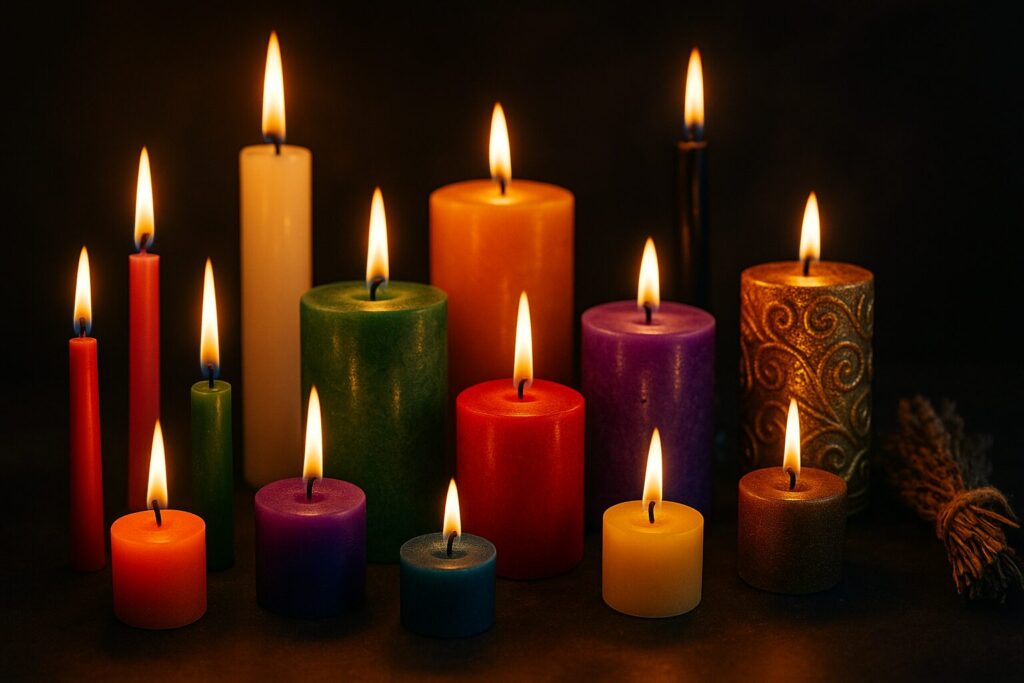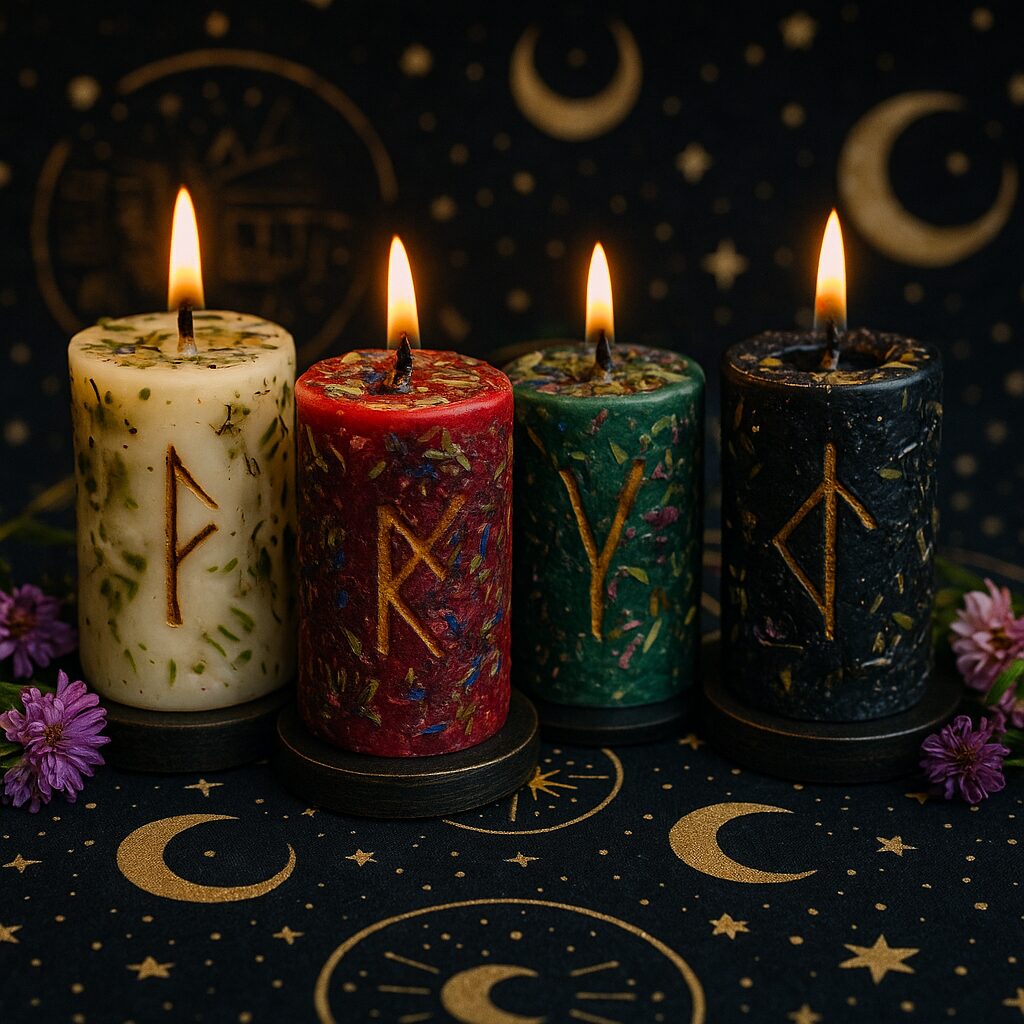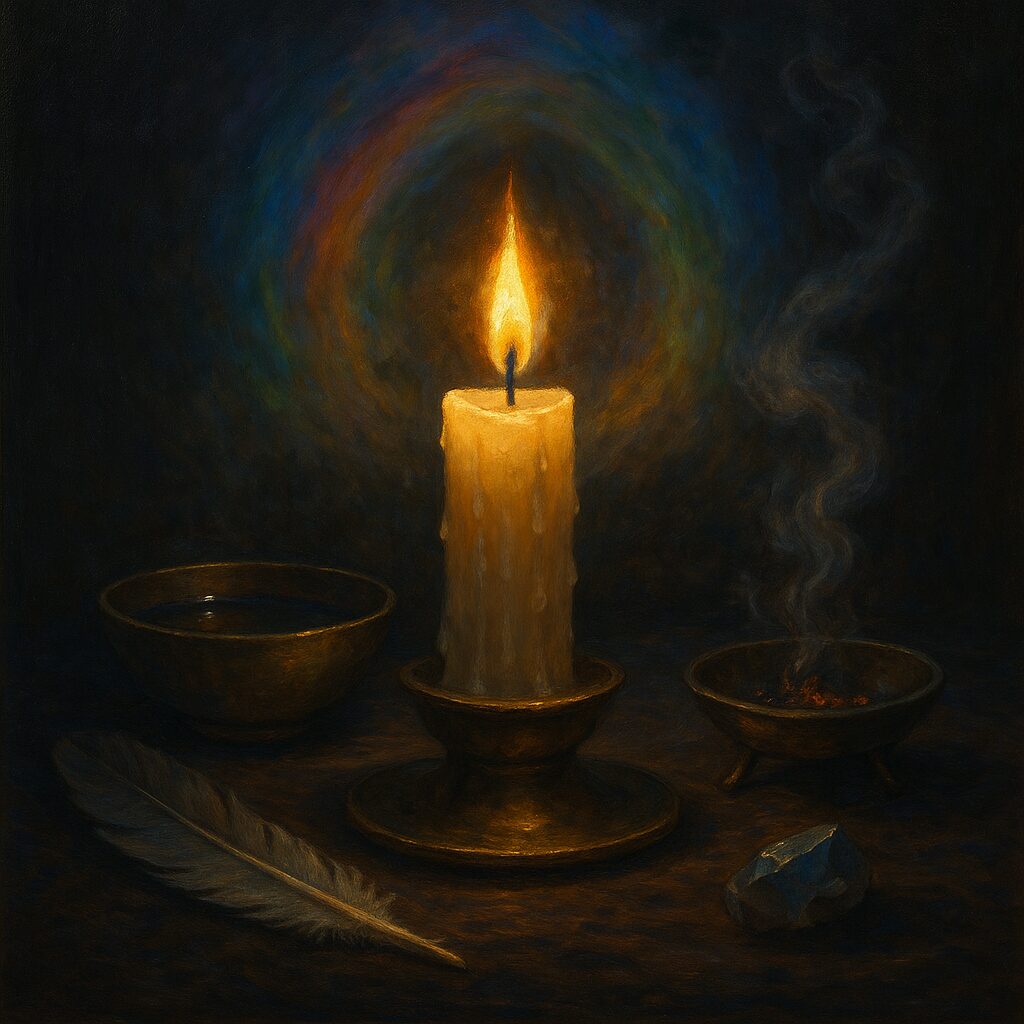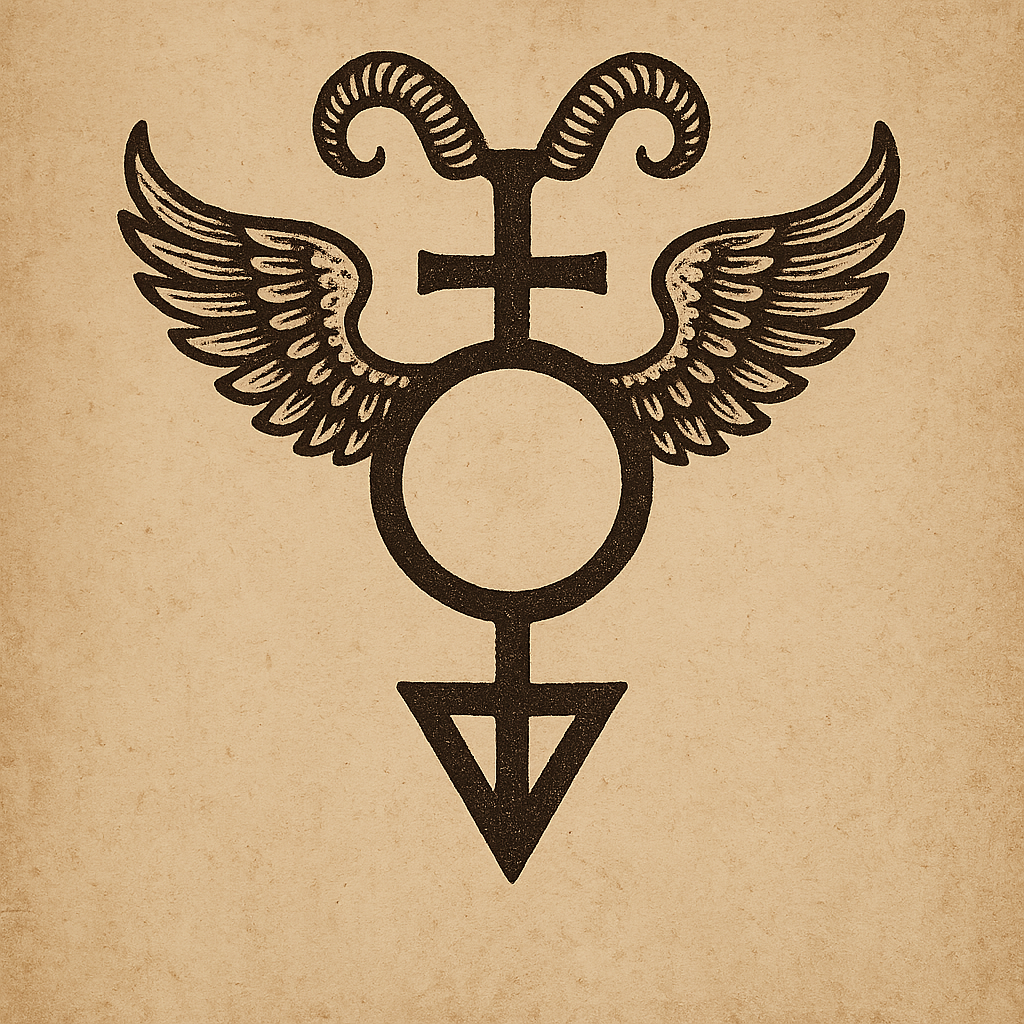Candles & the Art of Illumination

From the first oil lamps flickering in ancient temples to the beeswax tapers that crown modern altars, the candle endures as one of the simplest and most profound instruments of magic. Fire, tamed and given form, becomes both symbol and servant—its light a bridge between the seen and unseen, its smoke a breath that carries will into the subtle realms. Candles distill the essence of the Craft: transformation through focus, destruction in service of creation, matter refined into energy and light.
Across cultures, candles have long carried the light of devotion and transformation. From the votive candles of Rome to the temple lights of Egypt and the humble tapers of village hearths, the story of the candle is the story of magic itself—light shaped by human hands to call the sacred near. Each small flame speaks of continuity between spirit and matter, revealing that illumination has always been both an offering and a bridge between worlds.
In magical history, candles occupy a rare dual space: they are both instrument and offering. The ancients lit them in honor of gods and ancestors, marking thresholds between sacred and ordinary time. In later European folk practices, wax was molded into effigies or charms; the slow melting of the form mirrored the release or dissolution of intention. Wiccan, Hermetic, and Neopagan lineages continue this inheritance, using the candle’s flame as a focus for invocation, divination, and meditative trance. Its steady burn becomes a mirror of the practitioner’s will: clear, unwavering, and bright.

The candle’s simplicity hides its immense versatility. It may anchor a spell, measure meditation, signal an invocation, seal a working, or serve as the sole companion in quiet reflection. In meditation, the rhythmic consumption of wax becomes a gentle measure of time—each inch a passage, each flicker a reminder of impermanence. In ritual, the act of lighting a candle marks the awakening of sacred space: the moment when the mundane shifts into the sacred.
While any candle may serve in magical work, quality does matter. A candle that burns cleanly and evenly reflects harmony in the working. Natural waxes—beeswax, soy, or palm—tend to carry more vitality than synthetic blends; they hold energy well and burn with a living warmth. Handmade candles, whether poured, molded, or anointed by the witch, bear the imprint of intention and focus from their creation, binding energy into matter before flame ever meets wick. Yet all candles are capable of magic if chosen and consecrated with purpose.
A well-crafted candle should be colored through, not merely dipped or painted. Pigment woven into the wax ensures that the energetic correspondence of color infuses the entire burn—red for vitality and courage, blue for healing, black for protection and banishment, white for clarity and unity. Candles of poor quality or low wax density may sputter, drip, or tunnel, obscuring readings and wasting energy; for workings of precision or divination, such candles are best avoided.

Candles are also vessels for additional correspondences. Runes, sigils, or magical words may be carved or inscribed upon them to align the working with a specific current of intent. Herbs, resins, oils, or even small pearls and charms can be embedded in or pressed around the base to amplify potency—though always with respect for safety and clean burn. As the candle consumes itself, these elements release their subtle essences into the working, forming a layered dialogue of fire, scent, and will. In this way, the candle becomes not merely a holder of light but a living talisman, transforming as the ritual unfolds.
Though ruled by Fire, the candle unites all four elements: wax as Earth, the melting as Water, smoke as Air, and flame as Fire. In a single act of burning, it becomes a perfect emblem of elemental harmony—the material consumed to feed the immaterial, a union of body and breath, matter and spirit.

The reading of candles—observing flame, smoke, and wax—is both an art and an act of communion. A strong, steady flame often signals alignment and focus; flickering or uneven burning may indicate emotional interference or resistance. A rapid burn suggests intensity or urgency, while a slow, stubborn one speaks of endurance and gradual change. The color of the flame itself can shift—blue for heightened spiritual activity, yellow for clarity, red for passion or warning. Wax that runs clear and smooth shows a clean working; uneven pooling or shapes in the remnants can be read symbolically, much like tea leaves. Even the smoke tells tales: thin and upright for acceptance, swirling or erratic for confusion, heavy and dark for energy that needs cleansing or release. Every aspect of a candle’s life—the lighting, the burn, the drip, and the extinguishing—speaks to the inner and outer forces at play.
How one ends a flame carries meaning too. Some blow it out as a release; others snuff it gently to preserve the spirit of the working. Each act is a dialogue with Fire about closure, gratitude, and respect—a symbolic return of the borrowed element to its source.
Beyond spells and readings, candles remain deeply practical in the rhythm of witchcraft. They measure time in meditation, accompany scrying or journaling, mark the boundaries of sacred space, and offer light for quiet communion with spirits or deities. Lighting a candle before study or divination signals the shift in awareness; extinguishing it seals the work and disperses what has been raised. In this way, candles teach discipline and mindfulness: they embody the principle that illumination requires both fuel and focus.
Accessible to all, yet profound in their simplicity, candles express the triad at the heart of magic—will, form, and transformation. Whether crafted by hand or chosen with care, they stand as symbols of devotion and creativity, as mirrors of the witch’s inner flame. Through them, the act of lighting becomes an invocation; the act of burning, a meditation; and the act of extinguishing, a release. Candles remind us that in every flicker of flame lies both the spark of creation and the shadow it dispels—a lesson as old as the first hearth, still burning in the circle of the modern witch.

Candle Colors & Correspondences
White Candles — Purity, Unity, and Illumination
White represents clarity, protection, peace, and spiritual purity. It substitutes for any color when resources are limited. Used for new beginnings, blessings, or to bring light to confusion. Excellent for meditation and deity work involving clarity or truth.
Black Candles — Banishing and Transformation
Used for protection, absorption of negativity, and releasing the unwanted. In deeper magic, black represents the womb of potential — the fertile void from which new realities emerge. Often paired with white to balance shadow and light.
Red Candles — Passion, Strength, and Vitality
Aligned with the element of Fire and the root of life-force energy. Used in spells for courage, desire, action, or willpower. Red candles are ideal for empowering charms, rekindling love, or grounding energy into the physical world.
Pink Candles — Love, Compassion, and Friendship
Gentler than red, pink channels affection, harmony, and emotional healing. Used for self-love, nurturing relationships, and healing from conflict. Pairs well with rose quartz or gentle herbs like rose and chamomile.
Orange Candles — Creativity and Opportunity
Symbolic of enthusiasm and manifestation. Orange stimulates joy, adaptability, and attraction of favorable outcomes. Burn during creative work, success spells, or when opening new ventures.
Yellow Candles — Intellect and Communication
Linked to Air and Mercury, yellow inspires clarity, eloquence, and learning. Used in study, public speaking, or when seeking insight. Brightens thought and encourages optimism.
Green Candles — Prosperity and Growth
The color of nature, balance, and abundance. Burn for wealth, success, fertility, and healing of body or spirit. Ideal for workings involving gardens, business ventures, or long-term stability.
Blue Candles — Peace and Wisdom
Associated with Water, blue cools and calms emotional turbulence. Light for spiritual healing, dreams, or invoking serenity. Darker blues aid introspection and psychic depth, lighter blues support harmony and truth.
Purple Candles — Power, Intuition, and Spirit
Used to awaken intuition, enhance psychic ability, and draw higher guidance. Associated with Jupiter and the crown chakra. Ideal for ritual devotion, divination, and deep meditation.
Brown Candles — Stability and Home
Grounding and earthy, brown represents hearth and steadiness. Used for protection of the home, legal matters, and to strengthen commitment. Excellent for spells concerning animals or practical concerns.
Gold Candles — Solar Power and Success
Embodying sunlight and divine radiance, gold corresponds to prosperity, recognition, and divine blessing. Used in workings of confidence, leadership, and connection to solar deities or success magic.
Silver Candles — Lunar Light and Reflection
Silver channels the Moon’s intuitive and reflective qualities. Burn for divination, dreams, protection, or emotional balance. Useful in workings of psychic clarity, lunar worship, or scrying.
Special & Crafted Candles — Tools of Intent
Includes figure candles, anointed or herbal-infused forms, and hand-carved spell candles. Each can be dressed with oils, herbs, or inscriptions to align the working with precise intent. Always use safely and with clear focus—each flame is a contract of will and offering.

